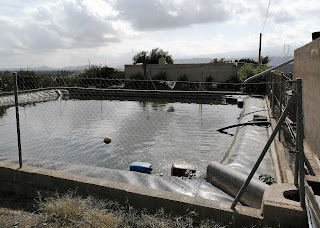In the old days, before the passing of Franco, the bars closed at 1.00am. Most of them no doubt closed a lot earlier, right after the black and white football game on the telly ended, but the bars in the tourist towns at least, would remain open for the boozy foreigners until the bell went. By the late sixties, prices for a gin and tonic had crept up to fourteen pesetas (around nine cents of a Euro), and a beer cost anything up to a duro – five pesetas. Our town lush, Old Antonio, would patrol the bars in Mojácar on the look out for a drink, looking more and more dishevelled after each invitación. ‘Rubio, dame un duro’, he’d whine.
The local bars were dressed in simple stone, marble, slate, tiles and plaster. There might be a calendar for decoration, the obligatory shelf of bottles, Green Fish gin and so on, perhaps a TV or a radio or a juke box – or with luck, all three. Noise was the keynote of a good bar, with the walls rebounding the sound and lifting it on high.
The few foreign bars would be decorated with paintings from local artists (who always attempted to drink for free) and would have the lights on low. Music came from a record player.
By 1.00am, those who wished to continue with the business of drinking would move to our solitary discothèque, run by Felipe, a Frenchman from Casablanca. Felipe would charge a little more for a cubata, the generic name for a mixed drink, but he had a disk jockey and a dance floor. At 2.00am, according to the rules, he’d close the door and pretend to be shut while we finished our drinks.
This could take some time, as the next legal establishment, the Fisherman’s Bar in nearby Garrucha, didn’t open until three.
In those days, the local Guardia Civil had to provide their own transport, which would generally be an old moped. They wouldn’t bother hiding behind a road-sign to catch the occasional drunk driver - they couldn’t stop you without ‘probable cause’ anyway - or, for that matter, tear along behind you shouting weedoo weedoo while waving their arms. For one thing, they'd have fallen off. At best, they might be in the village watching the small car-park and kindly helping drivers reverse safely out of their space and away down the hill.
The trip to Garrucha took about fifteen minutes and included a drive through the dust, ruts, or puddles, depending on the season, of the floor of the riverbed, the oddly named ‘Rio de Aguas’ that, in those days, more or less divided the two towns geographically.
Garrucha High Street was and remains, a narrow and ugly road that flows straight through the fishing village and away towards Vera and civilization to the north. In those times, it was a two-way street. Half way down it was the Bar Bichito, a bar with a special licence to open at 3.00am for the fishermen to have an early morning carajillo, a black coffee and brandy. This particular mixture always seemed like a good idea to the inebriates from Mojácar who would order a round as a song began to bubble up from within them.
Hitherto, the evening's drinking had been reasonably quiet, with the music taking the strain, but in the Bichito, fetchingly designed in white tile throughout and known to the foreigners as ‘The Lavatory Bar’, there was no music and entertainment had to be found elsewhere. The joint made ordinary local bars of the times look positively attractive. The door was on the end and opened into a narrow bar which stretched along in a small 'el' shape parallel to the street. There were two small tables and a few chairs just inside the door, and, if feeling faint, one could always sit outside on the curb. Otherwise, we stood at the chest-high bar (or even higher for some of the vertically challenged local fishermen), blinded by the bright lights and namesake décor and watched, between songs, as Pedro man-handled his one-spout Italian coffee machine. The toilet facilities, a throne with a long drop, were through the back and doubled as a storage room for the beer and soft drinks.
The fishermen and the old municipal cop would look on in a friendly way as the small group of plastered Britons, French, Germans and Americans, depending on the draw, would start on their lengthy repertoire. A family favourite of ours was ‘I Wonder Who’s Kissing Her Now’ (an old song immortalised in the late sixties by the New Vaudeville Band) followed, perhaps, by the popular drunken bawl ‘I’ve Got Sixpence’ or perhaps ‘Bless Em All’. A cockney couple, Pat and Tony Farr, had taught us a number of songs, such as ‘I’m One of the Ruins that Cromwell Knocked Abaht a Bit’ and ‘I’m Henry the Eighth I Am’ and so on.
More carajillos as Pedro, face pitted with acne, would tell everyone to hsss, to be quiet. People are trying to sleep (apparently).
Things could only get worse as the Rugby Songs were unleashed. Rugby Songs are England’s answer to folk music and run along the lines of ‘My Little Sister Lily’ or ‘They Were Tattered, They Were Torn…’ with lots of lines ending in –uck and so on. Curiously, many of them are set to opera music, which gives the performers a chance to really crank out the key words with enthusiasm. At times, even the extranjeros can be loud.
The ride home was always uneventful I’m sorry to report. No accidents or arrests. But those were different times. Cheap, basic and fun.





